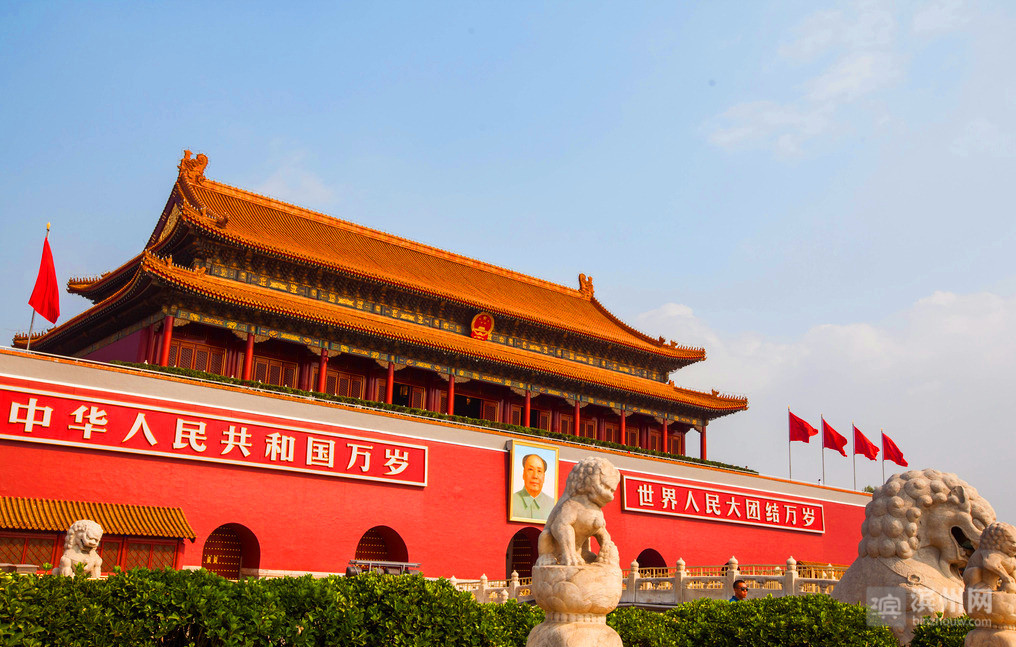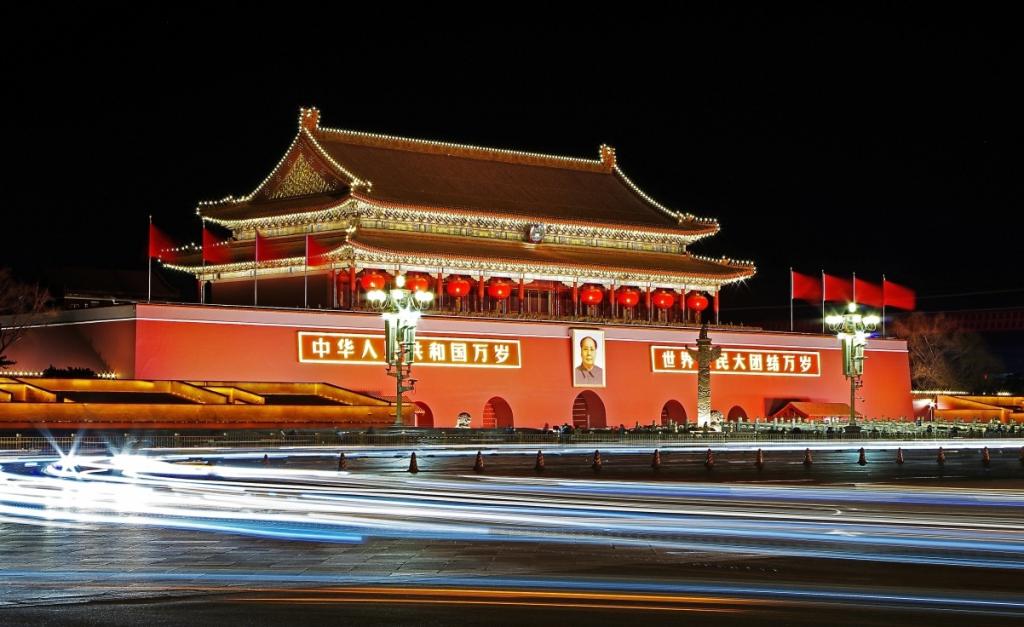Xian Tours
Beijing Tours
China Tour Packages
About

Situated in the heart of Beijing, Tiananmen Square is acknowledged as the world's largest city center square. The whole area is 172 000 square meters. From east to west, it spreads 500 meters in width and from north to south, it is 880 meters in length. The square is paved with light-colored granite boulder strips and can host one million people assembled at one time. There are 25 huge columns at the front of the frontispiece.
Tiananmen Square is where numerous major political and historical events took place in China.  On May 4th, 1919, the May Fourth Movement broke out here, the Chinese people declared war on imperialism and feudalism. On October 1st, 1949, Chairman Mao Zedong declared the founding of the People's Republic of China, and personally hoisted the first five-star red flag in Tiananmen Square to say good-bye to humiliation and slavery. As a witness to numerous major political and historical events in Chinese society, Tiananmen Square is also surrounded by many other buildings that bear great importance in Chinese history. On the west of Tiananmen Square stands the Great Hall of the People, it is the meeting place of the National People's Congress of the People's Republic of China. There are also Monuments to the People's Heroes and Chairman Mao's Mausoleum to the south.
On May 4th, 1919, the May Fourth Movement broke out here, the Chinese people declared war on imperialism and feudalism. On October 1st, 1949, Chairman Mao Zedong declared the founding of the People's Republic of China, and personally hoisted the first five-star red flag in Tiananmen Square to say good-bye to humiliation and slavery. As a witness to numerous major political and historical events in Chinese society, Tiananmen Square is also surrounded by many other buildings that bear great importance in Chinese history. On the west of Tiananmen Square stands the Great Hall of the People, it is the meeting place of the National People's Congress of the People's Republic of China. There are also Monuments to the People's Heroes and Chairman Mao's Mausoleum to the south.
Every morning, there is a national flag raising ceremony, and at every sunset the flag is lowered. It is a very solemn ceremony. Strolling in Tiananmen Square, looking up at the magnificent layout, the majestic momentum, the vast and deep landscape, you will feel the rapid development of China.
In the Yuan Dynasty, Emperor Kublai changed Yanjing (current Beijing) into the Great Capital and the new palace was built.
In 1368 (early Ming Dynasty), the famous general Xu Da led his troops into the capital and changed the name into Beiping.
In 1403, Prince Yan Zhu Di altered the name again to Beijing and moved his capital here.
In 1417, the emperor Zhu Di employed craftsmen from all over the country to rebuild the capital, this was when Kuai Xiang (from Xiangshan, Wuxian, Jiangsu Province) began working on his great design and began the construction of The Gate of Heavenly Succession. After 3 years, the construction was complete.  A large plaque was hung in the middle with the four characters “承天之门” (the Gate that lead to the imperial palace. “承天(Chengtian)in Chinese means that someone/something is chosen by the heavenly god here refers to the emperor”. So this phrase means that the Gate lead to the god-chosen Emperor).
A large plaque was hung in the middle with the four characters “承天之门” (the Gate that lead to the imperial palace. “承天(Chengtian)in Chinese means that someone/something is chosen by the heavenly god here refers to the emperor”. So this phrase means that the Gate lead to the god-chosen Emperor).
In 1456, the gate was destroyed by lightening. In 1465, the Gate of Heavenly Succession was rebuilt and it become the largest and highest building in Beijing.
In 1644, the joint fighting between Li Zicheng’s rebellion army and the Manchu-led Qing Dynasty troops caused great damage to the gate.
In 1651, during the reign of Emperor Shunzhi in the Qing Dynasty, the gate went through a thorough repair and was renamed as the Gate of Heavenly Peace (Tian’anmen). It went through several restorations but remained intact until the Eight Nation-Alliances invaded Beijing and ransacked this great gate.
Prior to the foundation of the People’s Republic of China, the communist party decided to repair the Gate of Heavenly Peace and clear the city on a large scale. On Oct.1 1949, the foundation of this new China was solemnly declared here. Since then, Tiananmen Square has undergone a number of restorations.
1. During World War I when the western powers struggled against each other, Japan took advantage and invaded China encroaching on Chinese sovereignty. The anti-Japanese sentiment soared drastically. In 1919, the Chinese foreign minister failed to defend the country at the Paris conference, which triggered the great May Fourth Movement led mainly by the youth. They led the common people and businessmen to protest against the weak government by marching, petitioning, striking and even by using violence. This event had an important influence on the origin and development of the Communist Party in China.
2.On Oct.1 1949, Tiananmen Square served as the very site that Chairman Mao proclaimed the foundation of the People’s Republic of China.
3.The third historical event is the Tiananmen Incident. On Jan. 8 1976, people were filled with sorrow at the passing away of Premier Zhou Enlai, when the “Gang of Four” suppressed the mourning and conspired to frame Deng Xiaoping (later chairman). During the Tomb-sweeping holidays, millions of people congregated in Tiananmen Square and grieved for Zhou Enlai. The crowds supported Deng Xiaoping and condemned the “Gang of Four”, which frightened the great “Gang of Four” and they just gave a false color to the event and deceived the chairman and other superior leaders.

On April 4, the central government gave an order to clear all the flowers and sloganson Tiananmen Square as they deemed this incident an anti-revoluntary act. On the next day, more people came to the square and vowed to return the wreaths and protested against the government’s action. In the evening, about 10,000 militiamen, 3,000 policemen and 5 regular troops were assigned to suppress the people. Many people were wounded and jailed. Since May 1978, this incident was recognized as a righteous revolutionary action
4.The last protest happened in 1989 after the death of Hu Yaobang. Some people incited others to protest against the government and this incident led to many martyrs as well..
5. Tiananmen Square also served as a site for Military Parades after the founding of the People’s Republic of China. On each anniversary between 1949 and 1959, a mass military parade was held in this square to showcase the military achievements and to build up national pride. The parade was abandoned for 24 years until in 1984 when Deng Xiaoping thought it was time to introduce the military parade again. That same year, the government held a military parade to celebrate the 35th anniversary of the new country. In 1999, a grand century military parade was hosted in Tiananmen Square for the 50th anniversary of the new China.
At the center of the square stands the Monument to the People's Heroes and the solemn Chairman Mao Memorial Hall. On the west side of the square is the Great Hall of the People and on the East side is the Museum of the Chinese Revolution and the Museum of Chinese History. On the south side are two ancient towers which were built in the 14th century - the Zheng Yang Men and Qian Men Embrasured Watchtowers. On either side of the Tian An Men are the Working People's Cultural Palace and the Zhongshan Park. The whole square is magnificent, neat and symmetrical.
One of the more unusual features of Tiananmen is a pair of 10-meter-high white marble columns (huabiao) topped by a "dish for collecting dew." A carved stone animal known as a "heaven-gazing hou"(a small, lion-like legendary creature) squats inside each dish. These dishes were used to catch the "jade dew" imbibed by the Emperor to ensure long life.Location: East Chang'an Street, Dongcheng District, Beijing (the center of Beijing)
Highlights
1949 - The founding ceremony of the People's Republic of China;
1986 - Recognised as one of the "Beijing 16 Scenes";
2013 – Honored as the world's largest city central plaza.
Recommend Visit Time: about 40 min
Opening Hours: Whole day
Day Tour to Forbidden City and Great Wall 2 Days Beijing Expedition Tour from Tianjin Port
Copyright © 2019 Lily Sun China Tours International, Inc. Terms &conditions | Privacy Policy | Sitemap